Amateur radio related diary
News items 2023
News items 2022
News items 2020-2021
News items 2016-2019
News items 2015
News items 2003-2014
Latest news and comments 2024
![]()
Amateur radio related diary
News
items 2023
News
items 2022
News
items 2020-2021
News
items 2016-2019
News items 2015
News items
2003-2014
Update
10/4/2024:
I have
been rather busy recently so I have not had time to update here but I have
been very active on the air.
On 6 April I managed to active my second
POTA park, Baviaans Kloof (ZA-0075). The weather was really miserable with
wind and rain for 3 days so I ended up activating from a cabin in the park.
Band conditions were not great and my antenna was just the EFHW thrown over
the (rather wet) roof of the cabin.
I did manage to make a few local
contacts on 40m SSB (and one local CW contact on 40m) but I had far better
results on 10m and 12m. All the DX contacts were on CW running 5W. I managed
to make contacts into the USA, Europe and even a few into South America. A
notable contact was with KP4M in Puerto Rico! I am looking forward to the next
activation!
On the DX front I have managed to add no less than 5 new
(confirmed) DXCC entities to my QRP CW total! This is the best result I have
had in years!
To top it of I managed to work A8OK (Liberia) this
morning on 40m for another new one!
After recently having a problem
with my hexbeam antenna, the mast fell down in a heavy wind when a guy rope
broke, I managed to fix the loose clamp at the rotator and raise the mast
again so the antenna is fully functional again, ready for some more DX!
Update 25/3/2024:
Yesterday
I ran a full charge - discharge - charge cycle on the "22Ah" Lithium battery I
bought for POTA. Well, to my not so big surprise my suspicion was confirmed,
the "22Ah" battery is actually a 12Ah battery! Seems like you cannot trust the
specifications of stuff that is manufactured in China! Shame on you!
I
opened up one of the two packs a have only to find a battery, shrink rapped,
in the case that does not even fill half the case.
But all is not
lost, I operated for more than 2 hours at mostly high power and used 5.2Ah so
the pack would be good for at least 4-5 hours of high power use and more than
double that for low power use. Perfect for POTA and SOTA use. That combined
with the light weight, and maybe smaller size as I am considering removing the
"real" battery from the pack to save space, still makes this a great POTA/SOTA
battery, just a shame about the lies from the manufacturer (Ingle)!
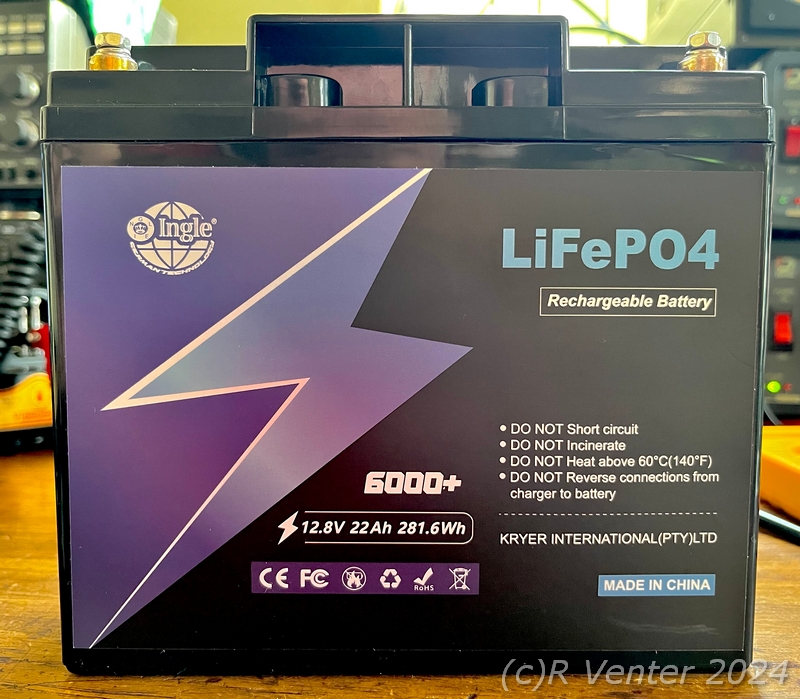
The "22Ah"
battery that is actually 12Ah.
I have registered a few more local parks, as people request new parks I check
if they meet the criteria and if they do I register them. Now we just need a
few more people activating!
I have not been actively hunting POTA
parks, till now anyway, but I was pleasantly surprised to see on the POTA web
page that I have already been awarded a certificate for working parks in 5
different DXCC entities!
5 Counties
POTA award.
Seems like our autumn is still not here, the weather prediction still shows
very hot weather for the next 10 days, I really want to do another activation
but not in the heat, will watch the weather carefully.
Next weekend is
unfortunately most likely not going to work anyway. It is CQWW WPX SSB
weekend. I was not going to compete, it is SSB and not CW, but I have just
received a personal invite from the organizers to compete so I think I will,
but only a low key effort to hand out some points and multipliers.
Update 23/3/2024:
I had
fun activating POTA entity ZA-0078 (Suikerkop Hiking trail) yesterday
afternoon. It was not an easy activation. Band conditions were down during the
time I was activating, I could hear stations on 10 and 15m but they were way
down. Eventually I did manage to make a few DX contacts but 2 weeks earlier
same time of the day I worked over 100 DX stations from my field station.
There were also weather issues, it rained twice, hard enough and with
lightning in the area that I took the antenna down twice and had to find a
place to hide. After the second time I went back to my vehicle, fortunately it
was parked at the start of the trail, within the 30m specified in the rules so
I just completed the activation from inside the car while it was raining
outside.
The Yaesu FT-891 worked perfectly, it will now become my field
radio of choice unless I am planning a long hike.
The EFHW also worked
well. I used the new Spiderbeam 12m fiberglass mast. It worked ok but it is
far more flexible than I thought it would be. Even in a modest wind it bent so
much that the antenna was no higher than it would have been on my far stiffer,
and lighter, Comet 8m mast.
I need to decide on the mast, maybe if I
use a dipole that is fixed at 2 ends it would be better but with the EFHW with
only one side tied down it bends far more than what I would like even with
modest tension on the antenna, the antenna was still sagging quite a bit so I
could not put less tension on the antenna.

Look how far
the mast bends with the EFHW, and the antenna is not even under much tension!
I am already planning the next activation, it will most likely be ZA-0075,
Baviaans Kloof, as I was there during the SARL field day and it was a great
location. Back then it was not a registered park but it is now. I will use the
same setup but might go back to the Comet mast.
A more complete report
on the ZA-0078 Suikerkop Hiking Trail activation can be found
HERE.
Update 22/3/2024:
Band
conditions were not great today, maybe it was fortunate! I have been busy
setting up the new radio for POTA, checking the capacity of the batteries and
loading software on the new laptop that I want to use for POTA logging and
Winlink email in the bush.
The new portable mast (Spiderbeam 12m) arrived today. It is
really well made and it seems quite sturdy, I did not have time yet to fully
extend it. The mast is really sturdy and long enough for a 40m 1/4 wave
vertical antenna.
Unfortunately the mast is quite heavy (3.3kg), far heavier than my Comet mast! So
I suppose it will only by usable for activations where there is no hiking
involved. So for now when I want to do a bit of hiking in areas with no trees
the Comet mast will have to be lugged along. this will limit the length of my
hikes in the area where I live due to the lack of trees.
I have started
work on the POTA side of this page, it is still very much "work in progress"
but the first bits can be seen
HERE.
It was an extremely hot day, 41C and even
tonight it will be hot. If the temperature drops a bit by tomorrow as it is
suppose to I want to activate POTA entity
ZA-0078 tomorrow afternoon, let's hope for the best!
Update 21/3/2024:
I have
been quite busy with POTA (Parks On The Air) lately. After contacting the
local represented to try to add a few parks, and getting no reaction, I
contacted POTA in the USA. After a lot of discussion I am now happy to
announce that I am now the official admin person for POTA South Africa.
After announcing this on a few local forums I immediately had requests to
add new parks. So far I have added 5 and there will be lots more in the
future. 2 Of the entities I added are Baviaans Kloof, where I was during the
SARL field day recently, and the Suikerkop hiking trail, a hiking trail close
to me.
Depending on the weather, we are suppose to have a few rainy
days over the next week, I will be activating Suikerkop hiking trail soon. I
would prefer to do this over a weekend to give the opportunity to as many
locals as possible to work the POTA activation.
I have started a
separate POTA log for future activations and updates, it can be found
HERE.
On
the POTA subject, the new radio that I am planning to use for SOTA and POTA,
the Yaesu FT-891 has arrived from the USA. I will still using my smaller
radios, the FT-817, R928+ and X6100 for activations where I need to do a lot
of hiking and weight is really important but for normal POTA activations (and
mobile use) the plan is to rather use the FT-891.
I will be running it
at 5W on CW most of the time but if conditions are bad or I want to do an SSB
activation (every activation will also include SSB so as to not exclude the
majority of local, non CW, operators) I do have the option to run up to 100W.
The radio is also surprisingly small and compact, I will have no issue to put
it in a backpack for short to medium hikes.
First impressions of the
radio are great. Build quality is simply so much better than the Chinese
radios! The filters work really well and with a 3KHz roofing filter standard
as well as IF DSP variable band with it is really a great CW (and SSB) radio.
It also has a superb APF (Audio Peak Filter) that is simply amazing to dig out
a weak CW signal, well done Yaesu!

First QSO's
with the FT-891, the very first one was with a station in Qatar for a new one
on 12m.
Once I had the radio unpacked and connected I spent some time getting to know it, first few contacts on 10 and 12m included a new band-slot, Qatar on 12m plus some other good DX. I also spent about 30 minutes in the evening (9pm to 10pm local time) CWT session and it performed perfectly.

A look
inside the FT-891, top.

Bottom
view.

Dual fans, the radio is running quite cool even at 100W.

Final
amplifier section, very well made.
The construction and general layout of the radio is great, you can see Yaesu
have been in the business for a very long time.
A few quick checks show
that the radio draws around 700mA in receive, a bit more than the X6100 at
450mA but not enough to make a noticeable difference. Even at full power it
only draws around 17.5A so that is great, running at 5W we are sitting at
below 2A, far better than radios like the IC-7300 or my older FT-897.
Surprisingly the radio will produce over 120W on the few bands I checked, I
will never use it at those levels but it is very different from many other
radios that struggle to produce the 100W they are advertised as being capable
of producing.
This morning I used it for the full 1 hour CWT session on
40m and I loved it, I can see that I will never wish I had a "decent" radio
again when I am in the bush. After the initial test running on a power supply
in the shack I connected the radio to one of the new Lithium battery packs I
ordered for POTA and SOTA activities. The batteries are great, they are really
compact and far lighter than expected. I now need to do a few tests to see how
much operating time I can get out of them but after running the very busy 1
hour CWT session this morning rough calculations tell me that I will get more
than 6 hours of operating time (on high power) on a charge, and that is
when I spend a lot of time transmitting.
The advertised capacity of
the batteries are 22Ah, I must say I am a bit suspicious of that due to the
light weight but I will run one down to its cut-off limit as set by the BMS,
this is at 75% discharge, and then charge it with my Victron charger that will
show me how much it put back into the battery.
A nice feature I have
noticed on the Lithium packs are that they hold their voltage far better under
load than the older lead acid batteries I used in the past when I needed more
capacity than what my (model aircraft) LiPo packs could provide. Lead acid
batteries dip below 12V under load very quickly but with the same load the
Lithium packs sit at over 13V for hours.
Fun times! I am also expecting
a light, portable composite 12m mast to be delivered over the next few days.
It is both taller and much lighter than the 8m Comet mast I have been using so
it should be far easier to carry on the longer hikes.
Update
14/3/2024:
The results of
the 2023 CQWW CW contest has now been released. As expected it did not go as
well as I hoped. The extreme QRM that I had on the second day just as the
bands started to open really hurt my results. Anyway, that is now history, you
can read the full report on the contest, and the challenges I faced,
HERE.
Here are the Results:
31'st Place in the world (As an indication of how
bad things were, I have won this contest in the past)
First in Africa
First in South Africa
First Zone 38
New South African, African and Zone 38 records.
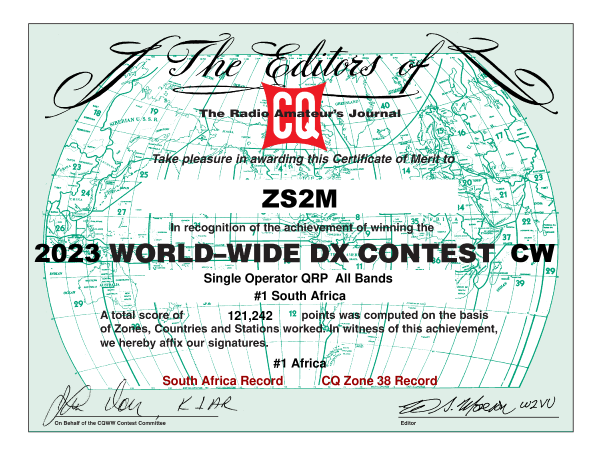
Certificate received
Well, hopefully things will be better next time, it was still fun!
On a different note, as I posted a while ago I have been looking
for a Yaesu FT-891, for mobile and portable use, for quite a while. I got a
lead on one in an estate a few days ago but it turns out it was not available.
So I decided there is little change of finding one locally, the easy solution
was to order one from the USA. Well I placed the order yesterday, it should be
here 20 March, looking forward to taking it out on a POTA or SOTA activation
soon.
Since I might want to run slightly higher power with this radio,
specifically on SSB as 5W SSB on a low antenna does not really give great
local results, I also need to look at the battery I will use with this setup.
I have found a few options locally, a 18-22Ah Lithium pack seems to be the
solution, will order something soon. I just need to look at the size, shape
and weight of these packs to decide on one that will fit in my backpack best.
Update 11/3/2024: The day after Field day!
It was fun! The
weather was great, not too hot with a light breeze to keep things cool. The
5km hike was fun, everything I needed for camping was in my normal backpack
and I also carried a small "pouch" with my radio equipment. I ended up taking
the Xiegu X6100 but I left the Micro PA50 amplifier behind, mostly due to the
fact that I did not feel like carrying the extra batteries it would need, it
turned put to be a good decision as I never felt I needed more than 5W, the
X6100 can do up to 10W with an external battery so I did have some power (1/2
S point) in reserve.
Logging was done on an iPad. I actually wanted to
do paper logging but forgot the paper and pen at home! Fortunately I had the
iPad with me, I use it for navigation and to have something to read when I am
in the tent at night.
The antenna I took was the (now well loved) 40m
EFHW kept aloft with my 8m Comet mast. This is one thing I need to change,
this mast is fantastic but simply too heavy and clumsy to carry. Time for a
nice compact carbon fiber mast!
I found a nice spot to camp and put up
my station below a wild prune tree/bush. It is supposed to be a tree but they
never grow high in this area, there was just enough height to sit below it. It
gave me great protection from the sun.
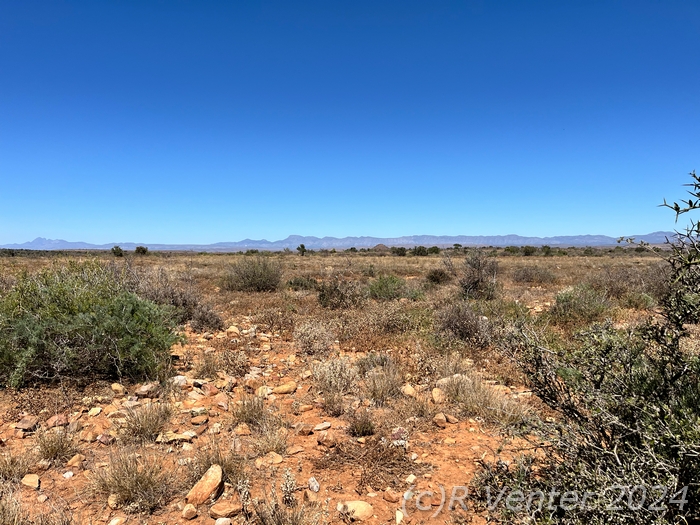
The view from my operation position. Yes, it is a
very dry area!
I soon had the antenna up and the station on the
air. My first contacts were with local Field day stations on 40m SSB. The
setup was working well so soon I had everyone logged I could hear. I then had
a nice long chat to a few friends, was fantastic to hear all the stations so
strong, my noise level on 40m was below S1!
Late afternoon I moved to
10m CW and soon the DX was rolling in, there was a South American contest
running, I seemed to have great propagation into South America so by the time
my batteries were almost flat (I did not expect so many contacts so I miss
calculated and did not bring enough batteries, lesson learned!) I had more
than 100 DX qso's as well as a few nice DX chats in the log. Great fun!
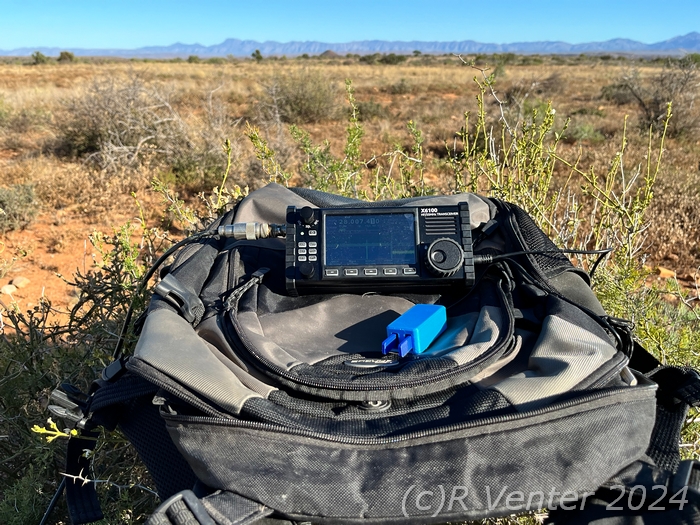
My very basic station in action!
After a good night's sleep, complete with Owls and
Jackals visiting, I managed to make a few more CW DX contacts on 40m before
the radio complained about the batteries.
As it turned out I had the
radio's "cut off" voltage level set a bit high, checking the batteries at home
showed that they were still at around 60% charge level, another lesson
learned.
It was great fun, the scenery, piece and quite and the
extremely low levels of noise on the bands made it special. I will be taking
my radio hiking again soon!
Update 7/3/2024: With field day getting close now (in 2 days time) I
was really happy to received a parcel this morning containing the radio I am
hoping to take hiking with me for this field day.
I decided to get a
Xiegu X6100 for a couple of reasons but the main ones are that it is nice and
compact, it has an internal battery that allows you to operate 2 to 3 hours
(or use an external battery) as well as an internal antenna tuner. The fact
that it is a modern SDR and runs Linux (so you can modify the open source
firmware) were also things that helped me make the decision.
First
impressions are great, it feels like a well built solid radio and the receiver
sounds great! I did not waste much time to get it connected and within minutes
of having it on the air I had made a few DX contacts on 10 and 15m. running 5W
CW I think I am going to like this one!

Solid feel, great (quiet) RX with a nice bright
display.
Along with the order I also received the little Micro PA50, a 50W, auto PTT sensing and auto band switching amplifier. A perfect match for the small radios like the FT-817, R928+ and now the X6100 in my collection. 50W is perfect for that occasion when 5W is simply not enough and you MUST make the contact. 50W is only 1/2 of an S point below a100W radio so the small size and low current draw (measured at 7.8A for 55W output) makes it perfect for portable and hiking use. It will produce full output with only 2 to 3W of drive so it can be used with any small transceiver.

Micro PA50, displays output power, SWR, band,
voltage and Final temperature.

X6100 with
PA50 on the bench, also note new "Pico" 3D printed CW paddle, ready for the
first hike!
Time to start packing for Field day! My plan is do
an overnight hike into the Baviaans Nature conservation area. This is also
WWFF entity ZSFF-0057 so I am planning on activating that as well. I did
contact the local POTA representative to add Baviaans to the POTA list but after
a week of no reply I gave up on POTA, seems like it is dead in South Africa?
Maybe we just need someone else to run it?
Update
4/3/2024: I
have not posted any updates for a while, that is mostly due to being rather
busy but at least the busy includes amateur radio! I spend quite a bit of time
on the air every day, mostly chasing DX but also chatting to friends.
On the DX front I finally, after a year, received my QSL confirmations for 2
contacts I made with 9U5R (Burundi) on 10 and 15m, this is a, all time new one
on QRP CW so that was great!
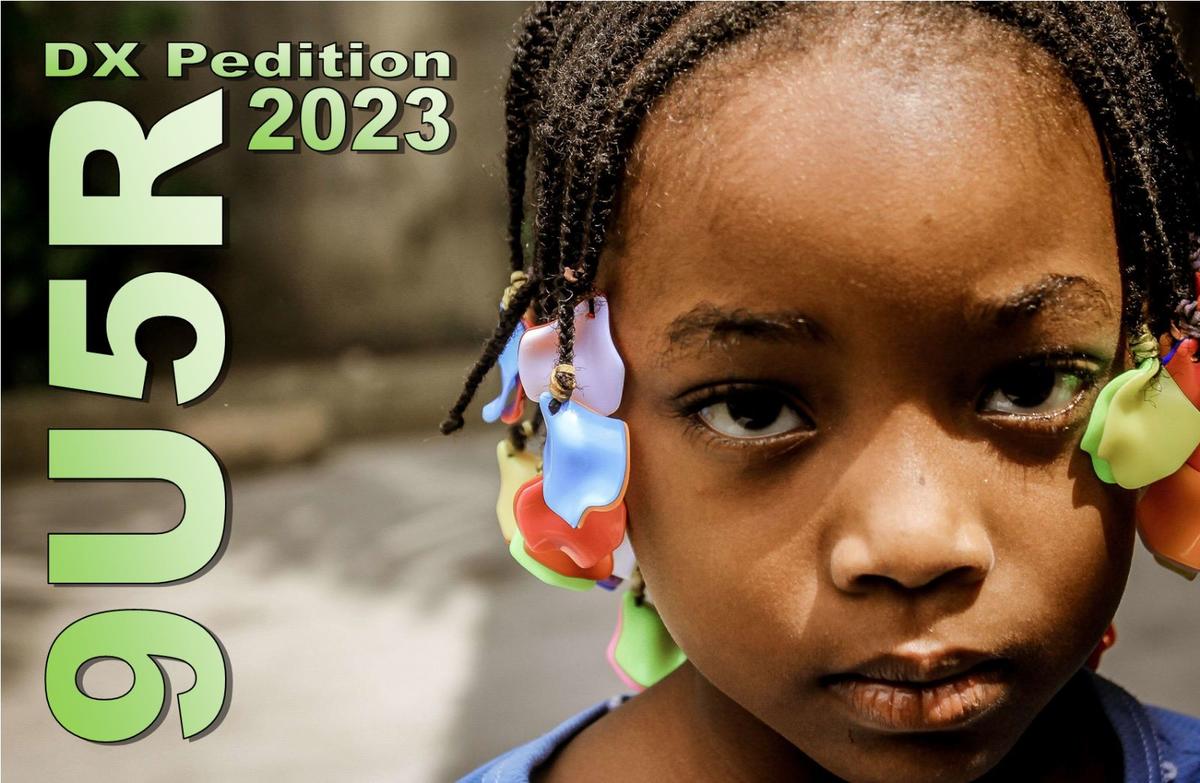
9U5R QSL card
Another new one, but
only on 15m, was 8Q7AM (Maldives), slowly the confirmations are coming in.
Update 27/2/2024:
I recently
received 2 QSL's from OX7AM, Alex in Kangerfussuaq Greenland, the 20m is not
new but the 40m is, slowly but surely the 40m total is increasing, it is
really not easy on 40m running 5W competing with the 1KW+ station but it is
fun!
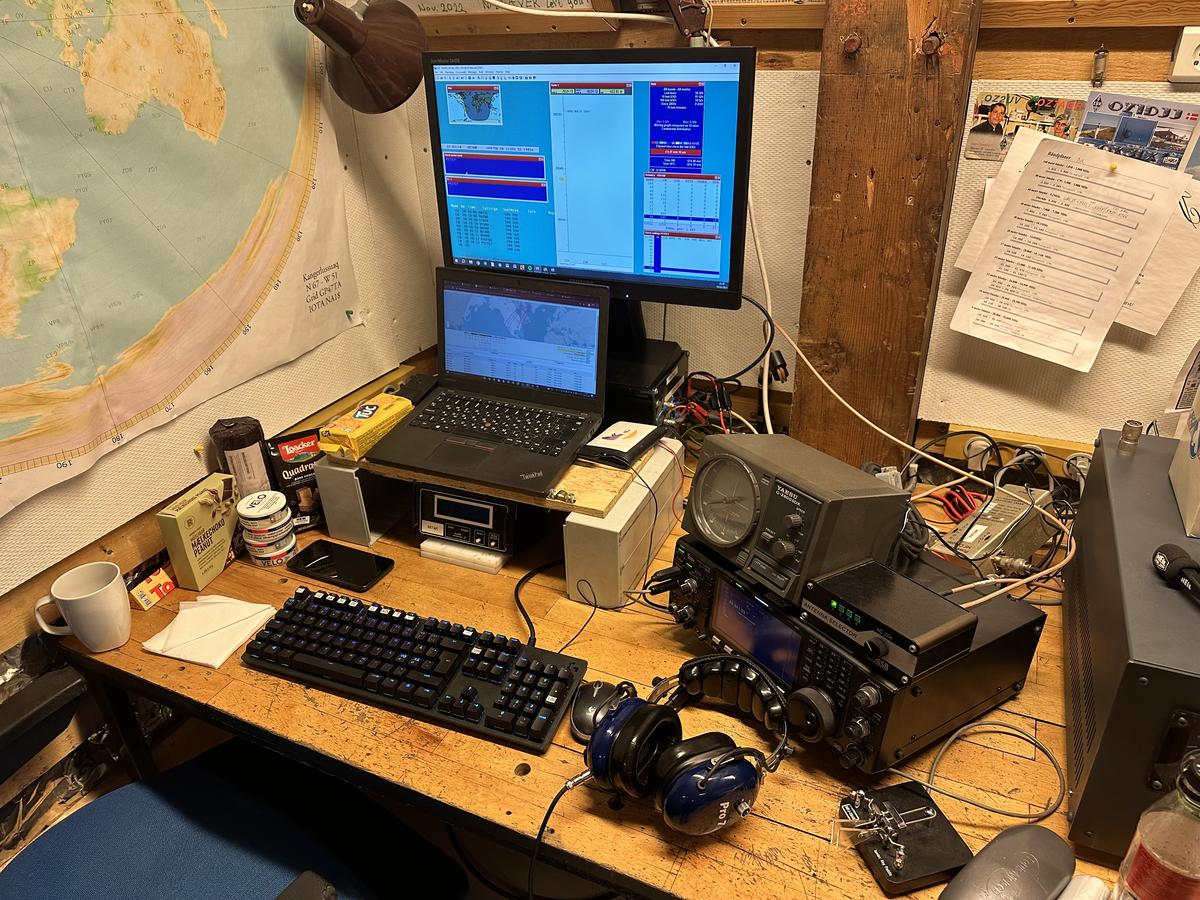
The OX7AM station in Greenland.
I also recently received a few QSL's from another
Alex, this time CT8/VE3MA in the Azores, this included a new one on 20m CW
QRP, quite surprising as I was sure I had worked Azores on all bands before,
it just shows that when you hear a station work him, no loss if it is a
duplicate.
The bands have been up and down, they will be really great
with signals everywhere then suddenly we have a solar eruption and then all
goes quiet, after a while, sometimes days, then weak signals appear again,
they slowly build till the next eruption!
We have a local field day
coming up on 9 and 10 March, I think it will be fun to do a full field day
again so I have been looking for potential sites. On a drive this morning I
think I found an ideal spot, it is on a bit of a hill and there is even a low
tree/bush that can give some shade, something that can be really scarce around
here!
Our seasons are turning with more cool days but we still have one
or two really hot days every week, I am really hoping the 8'th and 9'th will
be cool days else it won't be fun, shade or not, I have decided that if the
predicted max temperature is much above 35C I will rather stay at home but I
really hope that is not the case, I have already invested quite a bit to be
ready for this field day.
I still need to decide on equipment to take,
since the spot I have in mind will require a bit of a hike I do not want to
carry too much equipment. Since the plan is to overnight I also need to carry
a tent and sleeping bag as well as food and water. This pretty much rules out
a larger 100W radio, even if I had the FT-891 already the 100W would require a
large battery as I want the ability to stay on the air for the full 24 hours.
Even at reduced power levels 100W radios still draw more current than QRP
radios at the same power. This is mostly due to the bias current requirements
of transistors capable of 100W compared to transistors capable of 5-10W. The
larger radios also draw far more power on receive than the smaller radios,
Since I want to power my field station with a few smaller (2.2Ah)
batteries that I already have this rules out all my larger radios. With the
R928+ "awaiting spares" (Chinese clone finals died) it leaves my with only the
FT-817. I now it will work but I also know I will miss the decent CW filters
and QRM/N fighting tools that I have been spoiled with recently. BTW, my field
day will be mostly CW but I will also use SSB when the CW stations I can work
run out.
This lead me to look for a modern (SDR?) QRP radio that would
be available on short notice (less than 2 weeks till the field ay plus I need
to get to know the radio first). The only radio that I could find that would
seem to offer the performance I need, the light weight (800g including the
internal 3Ah battery and auto tuner), low current consumption (around 350 mA
in receive) AND is available is the cute little Xiegu X6100.
I have
read many reviews and watched many videos on this radio, some guys love it and
some hate it. The "problems" guys have seem to be mostly associated with BCI
(broadcast band interference from powerful MW commercial stations). Since we
no longer have stations like that in my part of the world it is simply not an
issue.
There were also many complaints about missing features (that
were advertised) and things not working as they should. Later videos and
reviews show that these issues have been sorted out with firmware updates.
The radio is really interesting in that it actually runs Linux so you can do a
lot with it and there is already a "third party, open source" firmware/OS
available for it.
Those who know me well will know my long time
involvement and love for Linux so this feature alone made the decision easy!
So I have a Xiegu X6100 on order and it will be shipped (from a local
supplier) today, with a bit of luck I might have it by the weekend or just
after the weekend.
I also ordered (another!) small paddle, what can I
say, still searching for the ultimate tiny CW paddle.
Xiegu X6100
For the field station I will used the EFHW (End Fed
Halve Wave) antenna kept aloft by my Comet 8m portable mast. After many years
of using dipoles and fan dipoles for portable and field stations I have now
fallen in love with the EFHW antenna! I like it so much I am planning on
putting up a heavy duty version for 80/40/20/15/10m at home as a backup to my
normal antennas.
Recent tests with a friend and some DX showed that on
40m at least the EFHW antenna, with it's highest point at about 5m,
works as well as my 40m dipole at 12m, plus it also covers other bands so it
seems like the clear winner.
Update 19/2/2024:
The day after
the ARRL DX CW contest!
It was fun! But it was also frustrating, my
usual complaint with the ARRL contests still stands, it is really frustrating,
as a non North American station, that you can only work North American (US and
Canada) stations, when you hear all these "rare DX" stations but you cannot
work them it is not fun. The ARRL should consider a slight change, make all
the US/Canadian states/provinces multipliers but still allow contacts between
"non" stations, even if it is just 1 point (as apposed to 3) per contact.
Unless that change is made as suggested by many non US stations this will
be my last ARRL contest.
I entered the single operator, non assisted,
all band, QRP class. Since my R928+ has an issue, zero output and I really
wanted to use a radio with a spectrum scope, I ended up using the IC-7300
turned down to 5W, antennas were a phased dipole (2 element wire yagi) on 40m
and a Hex beam on 20m, 15m and 10m.
All the equipment worked well,
other than the hexbeam that came loose again from the pipe connecting it to
the rotator, this is the only weak point in an otherwise great antenna! This
did not cause much trouble on Saturday as there was no wind but on Sunday the
wind was howling so the antenna was turning all the time. Eventually I went
outside and threw a rope over one of the legs so that I could prevent the
swinging. This helped and my "QSB" immediately went away!
I am not
going to write the full report here, if you are interested you can see more
detail
HERE.
A quick summary, running QRP I managed to
work 415 stations, this makes this contest the second highest number of QSO's,
by a small margin, of all QRP contests I have done. The top one still stands
firm at over 1000 QSO's over a weekend.

Very basic setup for the ARRL DX CW contest.
On the DX front conditions have be good, I have worked quite a few DX stations the last few days. I have also received my QSLcard from TZ4AM (Mali) for a new one on 40m.
TZ4AM QSL
Not much new on the equipment front, I have not
managed to find a Yaesu FT-891 locally so it looks like I will have to import.
I want this compact radio for SOTA/POTA activations as well as mobile work. On
that note, there is a chance that I might be involved in a DX'pedition to
Malawi and maybe other countries in the region, if/when there are any
developments I will post them here.
Update 14/2/2024:
I have been
active on the air every day since my last report but I have simply not gotten
around to writing about it!
The bands have been up and down but good
enough that everyday produced at least some DX. Recent QSL's include a new one
from Saudi Arabia on 12m plus the normal bunch of QSL's from Europe and North
America.
Interesting DX included CB0ZA from Juan Fernandez Isl. This is
a new one for me! Yesterday morning I heard their pile-up on 30m, it took me a
while to find them as they were very weak but eventually I manage to identify
the station causing the pileup, they were around S1 often dropping below the
noise floor but I was really happy to hear them.
It took me 25 minutes
of careful listening to finally get a reply from them with my 5W into a
dipole, I was REALLY happy to hear my call sign!
This morning I heard a
pileup on 40m, when I finally found them they were even weaker, could only
hear them every now and then as there was heavy QSB. Eventually, I was just
about to give up as the band was closing, in fact I already got up from my
chair, I gave one last call and they came back to me! A new DXCC entity on CW
QRP plus 2 band slots!
CB0ZA on Robinson Crusoe Isle, one of the islands
in the Juan Fernandez group.
Great to see my 2
QSO's in their log!
My little "portable/SOTA/POTA" paddle arrived today from China. I must say I was worried about the quality (it was cheap!) but it is actually a very nicely made paddle and I am sure it will last a very long time!

New paddle attached (via the magnets on the bottom)
to my trusty FT-817.
Now we just need some cooler weather for a few
SOTA/POTA activations!
On that note, I have been using the R928+ and
sometimes the FT-817 for portable operations recently. Well, I have finally
had enough of the R928+, it has had some issues in the past but now, suddenly,
it has zero output, I assume the finals are gone. I will order new finals but
I really do not trust this radio any longer, might use it "in the garden" but
not going to take it to the bush only to have some problem with it.
I
have decided to get a modern, reliable radio from one of the big 3 brands.
Since Kenwood no longer makes mobile HF radios they are out of the picture. I
did consider the Icom IC-705 but it is rather expensive and with the large
screen not that robust. I have also decided I want a radio that can do 100W,
that will make it usable as a mobile radio and when you are on a summit with
poor propagation the 100W can save the day.
I have decided to get a
Yaesu FT-891, it is solidly build (it is a Yaesu after all! No flimsy knobs!),
it is not expensive and it has decent filters plus CW and SSB "call" memories,
perfect for expedition and contest use in the field. It is also quite small
and compact, smaller than for example an IC-705 plus an amplifier.
The
only problem is where to find one, I have posted "Wanted" adverts locally but
I do not have much hope so it looks like I will end up ordering it from the
USA, I love this "Global village" world we are living in!
Update
7/2/2024:
I have been too busy lately to update this
page but I have been quite active on the ham bands. I DX just about every
morning as well as in the afternoon, that is in addition to my daily sked on
40m.
Band conditions have been good most of the time so there is always
something to work, the only problem for me has been the heat in the shack, we
have had some really hot weather recently, saw 45C a few days ago, since I do
not have air-conditioning in the shack, and it is on the north-east corner of
the house, always sun facing, it can get really hot. This has limited my
operating times to early morning and evening. It is time to install
air-conditioning in my shack!
I have been considering a new radio to
use for portable setup, specifically for SOTA/HOTA/POTA use. In the past I
used one of my QRP radios for this but to be honest this makes it quite hard
to reach the required number of contacts to make it a valid activation. Sure,
in the USA and Europe people do that all the time, but here in dark Africa we
simply do not have enough guys on the air close enough to you for that to
work. It is also not fair to the chasers who struggle to hear your weak signal
especially if they live in the city with high QRM levels. I love QRP but there
is a place for QRO as well, 100W and a wire can also be a challenge!
So
I am really looking for a nice compact radio, that I can carry in a backpack,
that does not draw too much current when only receiving, and can output from 5
to 100W when needed. A decent receiver with good CW filters will be a plus!
This will be both a CW and SSB radio as we simply do not have enough local CW
operators, who are active, to make CW only activations worth it.
I did
consider the IC-706mk2G that I had in the past, I can find one locally at a
reasonable price, but they are now old technology with a less than stellar
receiver, no decent filters and they draw quite a bit of current (up to 2A)
even when just receiving. They are also quite bulky by modern standards.
A radio that could well tick all the boxes is the Yaesu FT-891, it seems
to be nice and compact, has been tested to only draw around 1A on receive, is
well built and robust and has decent filters. Now I just need to find one!
Talking about a portable station, I have now received the 2 CW paddles
that I considered for portable use. They are both fantastic but also larger
and heavier that I would like. The Vibroplex Vibracube is stunning, but far
too fragile and heavy for portable work! It has now found a permanent place in
the shack.

Vibroplex Vibracube, stunning to use but heavy and
bulky.

The little Kent single lever paddle is quite a bit smaller and more compact, but still quite heavy. I could use when I do not have to carry the equipment far, it has a beautiful action and even though I was worried that I would have to relearn how to use it because it is a single lever paddle it turns out to be no problem. Seems like I do not use the double lever "squeeze both at the same time" feature anyway. I simply love this paddle and I am sure I am going to use it often!

Kent single lever paddle, smooth as butter and a
real pleasure to use!
So I am still waiting for my little stainless steel
hand-held paddle from China, no idea when it will get here, till then I think
I will simply 3D print a paddle again. I found a design that does not use a
"pen spring", a point of failure for me in the past so I will print one before
my next portable activation. I think it will be a while before that happens,
it is simply too hot this time of the year to go hiking.
I have been
listening on the CW segments of the bands a lot lately and I have noticed a
few things that I want to bring to operators, mostly local and mostly new,
attention, some things they do not know or were taught incorrectly and that
have now become a (bad) habit. I was going to do it here but I think it
warrants a separate article that I can submit to the local magazine as well.
If/when I do that I will post the link here.
Update 1/2/2024:
February already, time flies! The
last few days band conditions have been great. Yesterday afternoon during the
CWT session I managed to make 34 QSO's in 45 minutes on 10m, I have not heard
that many stations on 10m for a very long time. This morning at 0300Z 40m was
just as busy, I managed to work 39 stations in an hour, not bad for 5W and a
wire antenna!
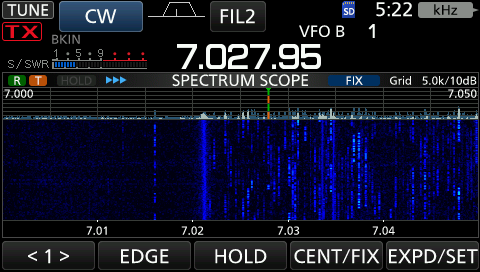
Lots of CW signals on 40m.
I am still waiting for my little "portable" CW paddle from China but I also found 2 nice compact paddles locally, both could be used in the shack or field and should be here long before the unit from China that is coming via the proverbial "Long boat from China".
Kent single paddle.
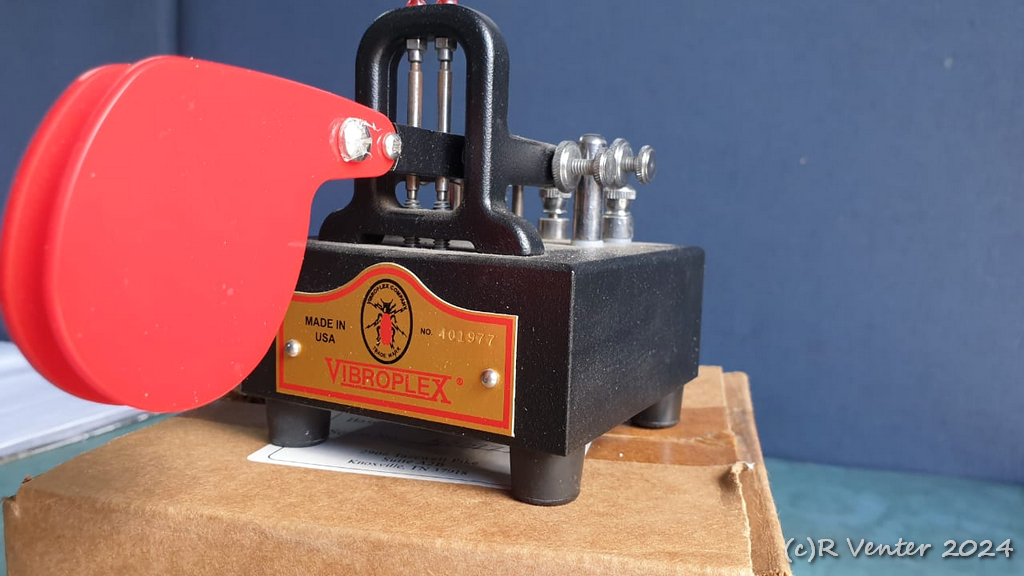
Vibroplex "Vibracube" with jewel bearings
I have never used a single paddle before but I am sure I will get used to it
quickly.
The cable with the 10 pin mini DIN plug I ordered for the
Yaesu FTdx-10 arrived this morning.
The plug is needed if you want to
connect a linear to the radio or in my case connect a QRM Eliminator that
needs a PTT signal from the radio. I have been using the radio without the QRM
Eliminator with good results but I really want the ability to connect it if
needed.
I can now also connect a linear amplifier for local SSB chats
or when joining nets with people spread over a large area, often some people
will have very high local noise and/or terrible antennas. Using an amplifier
in these cases makes it easier for everyone.
Update 30/1/2024:
The last few days I have only managed to
work a few DX stations every day, in general only one band was open at any
time with mostly weak signals. Well that changed today! I decided to do a
quick scan across the bands at about 14:00Z, to my surprise I could hear and
work strong stations from 20m to 10m with 12m producing the strongest signals.
I even managed to work a few stations on 17m, a band that I have always
struggled with from this location due to high noise. I must say it is really
nice to have a directional antenna that works on 12m and 17m, for more than 25
years I only had dipoles on those bands.
I have had a few nice QSL
cards recently, a new one was Finland on 12m (still many new ones to work on
12m!) and Alaska on 40m. Slowly but surely the totals are growing, lots of fun
especially when there are so many bands and DX stations to choose from.
I recently acquired a new solid state amplifier that I want to use for
local nets and chatting to my buddies. In the past I have usually used a
Kenwood TL-922 and it works well but we often jump around between bands to
find the best propagation and with a tube amplifier that is a pain as you need
to re-tune every time you change bands.
I did use my Metron T1000
amplifier for a while but it is a 12V amplifier so you need to provide it with
12V at 80A, not easy. The amplifier is also not fan cooled so with long overs
it can get quite hot, and I dislike hot equipment!
Anyway, I found a
Transworld TW500A amplifier, it is exactly the same amplifier as the Metron
but this one has a 15V 100A switch mode power supply built-in and it is
fan-cooled, just what I was looking for!

Transworld TW500A amplifier.
The amplifier produces a clean 600W when driven
with 25 to 30W depending on the band. It also seems to be running nice and
cool, looking forward to using it on SSB for some rag-chewing and our weekly
AWA net.
This amplifier was upgraded for a heavy linear power supply to
a nice and compact switching power supply reducing the weight by about 60%, a
great idea that got me thinking, maybe I should do the same to my Transworld
T1000 amplifier? That amplifier has a power supply problem at the moment, I
can most likely fix it but it weighs around 60km so it is not fun to work on!
It is so heavy because it is rated at 1Kw with 100% duty cycle on RTTY, was
used in it's previous life for RTTY communication between an embassy and it's
home country.
The Metron T1000 will now be used for portable/field
station use if high power is needed or maybe on the yacht.
Update 24/1/2024:
I have been trying to work the
Clipperton Island DX'pedition the last few days but so far no luck. I have
heard them 2 mornings on 30m and 40m but they were extremely weak and they had
huge pileups, on 30m this morning the pileup was nearly 40Khz wide.
Unfortunately I do not think there is much chance that I will work them, not
with 5W and most likely not even 100W or more. Their operating schedule is
such that they are on bands at times when we have little or no propagation on
those bands. On all other bands other than 30m and 40m that they have been
active on I have only been able to hear the pile-up and not them. This
combined with the fact that they are "behind" South America from here, close
to the USA and always calling "EU" shows that they have optimized their setup
for the USA and EU. They have forgotten about Africa and the rest of the
world.
Propagation prediction show that the best band to work them from
here, when I take their operating schedule into account is 30m and even on 30m
there is a "shadow" in the propagation behind South America from here.
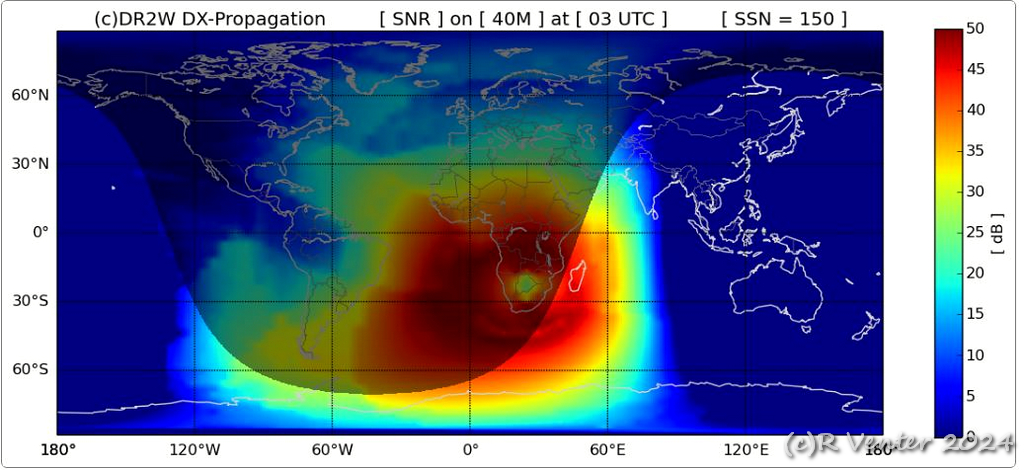
Propagation towards Clipperton on 40m, you can see
the propagation "shadow" if you look towards central America in the Pacific,
that is where Clipperton is.
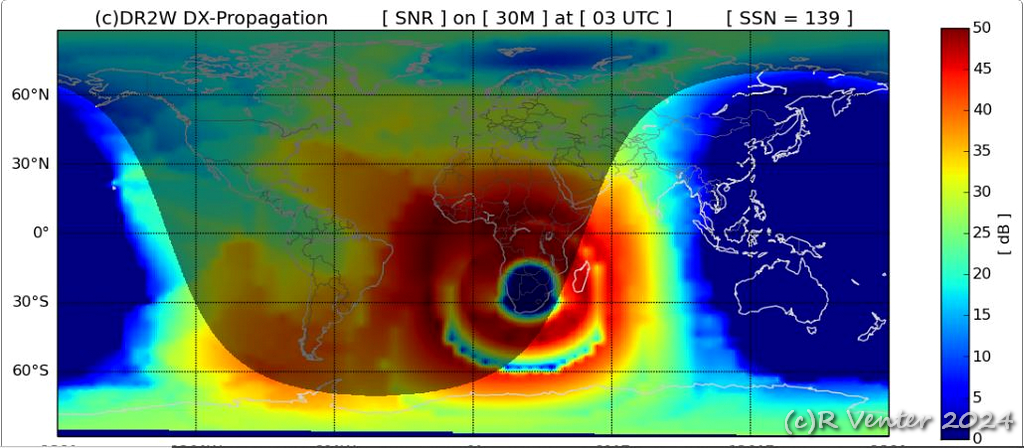
And the same
on 30m
So that is just the way it is, would have loved to work them on CW QRP but not
going to spend too much time trying unless they suddenly get loud.
I
did receive QSL's for Cameroon (TJ9MD) on 10m and 40m, both new on CW QRP and
also an all-time new one on CW QRP.
On a different note, after the
issues I had with my small CW paddle, the one I use when in the field, I
decided to look for something new. I wanted something compact but also robust.
Well I found a very nice unit made from stainless steel. It uses magnets to
attach to something like your radio and it also uses magnets to provide the
"tension" so no more springs to break!

Small CW paddle.

Attached to a radio, you can also just hold it in
your left hand like I am used to doing.
The only problem with this paddle is that the only shipping option was surface
mail from China so it is going to take a while to get here. The spares I
recently ordered from the same source for my QRM Eliminator too just over 2
weeks to get here, we will see.
I have been using a MFJ antenna
analyzer for years and it works well but it has limitations, it is large and
bulky, the one I have does not cover VHF and UHF and it can only really show
you SWR and impedance. The new generation of nanoVNA's (VNA = Vector Network
Analyzer) are really amazing, they can do so much, from basic SWR measurement
all the way to Smith charts. They can also be used to test feed line and
design and test coils and antenna traps.
I had an old nanoVNA but it
was one of the first devices and quite crude, also not reliable as it often
failed to boot and sometimes gave wild readings. So I decided to get a new one
and it arrived yesterday.
What a beautiful piece of equipment! I had it
going quickly and what a pleasure to use!

Nicely packaged, has the feel of "quality" that my
old one never had, that was just an open PCB!

Complete
with all accessories needed for calibration.

Nicely
built.
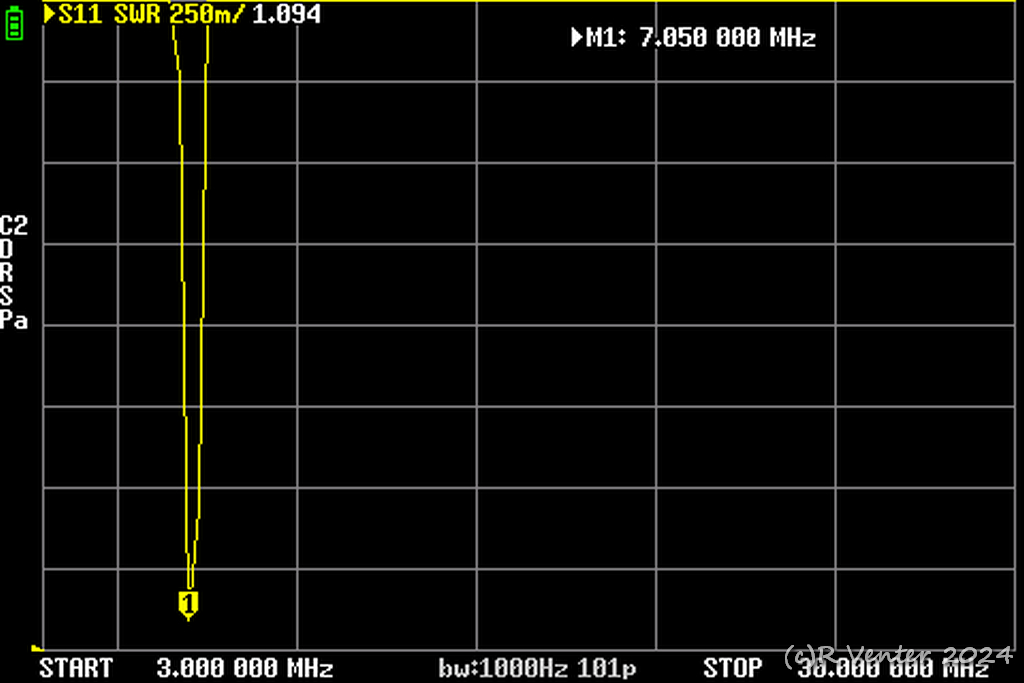
Just
using the simple SWR measurement, my 40m dipole, 1.094:1 SWR at 7.050MHz,
perfect for CW.
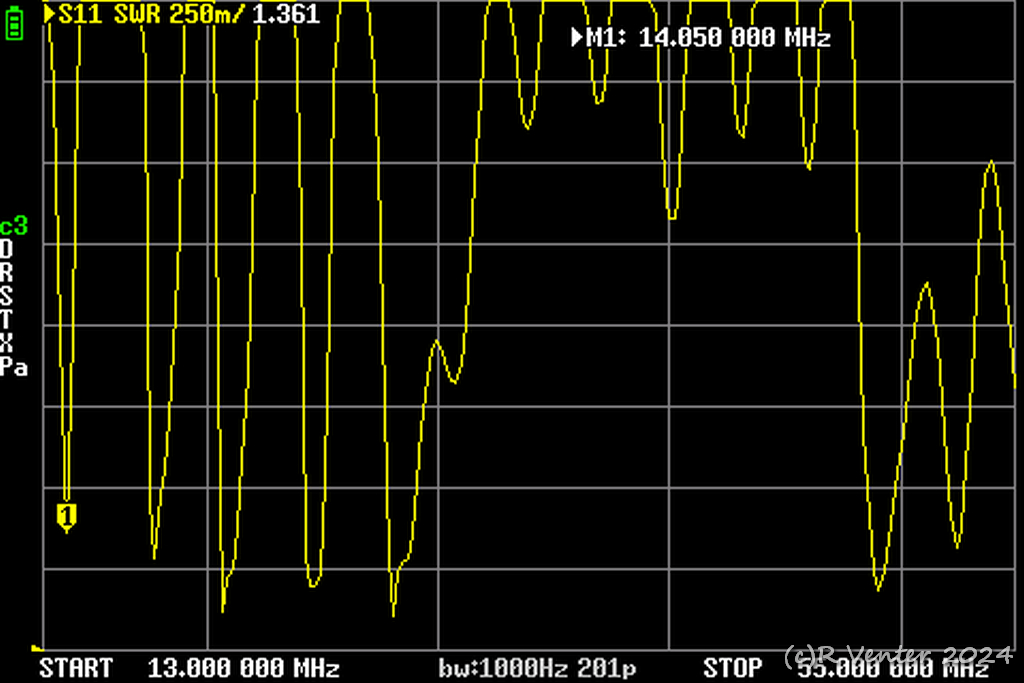
My hex
beam, dips nicely on all 6 bands!
With this nanoVNA I can now test my antennas far better and it is small and
compact enough to be taken into the field as well. I can now also setup my new
and as yet unused 2m/70cm yagi, the one I want to put up on the mast to try
and get into the coastal repeater network.
Update 21/1/2024:
Last night after my evening CW chat
I had to help someone with a computer, while helping I had a bit too much
coffee, well 2 cups that time of the day does not work well if I want to
sleep, anyway, I ended up going back, quite late, to the shack after the guest
left. To my amazement 40m was filled with DX stations and I could also hear a
lot of signals on 20m.
This was my first chance to use the FTdx-10 in
crowded and noisy band conditions. It really performed well! It is when the
band gets busy like this and you want to work weak signals close to strong
signals that you really see the difference between a radio like the FTdx-10
and something like an IC-7300 or other older radio. I switched between the
FTdx-10 and the IC-7300 a few times and the difference was really obvious on
weak signals. When you want to work strong signals on a less crowded band it
is easy to think the receivers are the same but they are NOT!
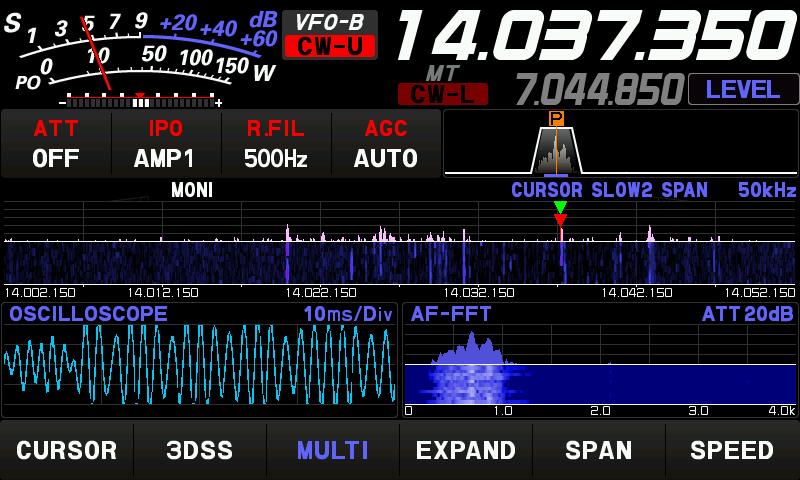
Working weak signals on 20m
In the image above you can see, on the AF-FFT display bottom right, 2 CW
signals within the same narrow band-pass filter, right next to them but
outside the filter is a strong carrier. The signals were both easy to copy and
you could separate them with either a notch filter, you notch out the unwanted
one, or by narrowing the filter to 50Hz, on the IC-7300 those signals sounded
like one carrier that was un-readable plus they were very weak because the
close carrier de-sensitized the receiver, I could simply not separate them or
copy what they were sending, if I did not hear and see them on the FTdx-10 I
would never have known there were 2 signals and that both were workable.
Please understand that I am not saying the IC-7300 radio is a bad radio!
It is a great radio and also great value for money, 90% of hams will be more
than happy with it, it is simply a case of the FTdx-10 being really special,
as reported by the Sherwood Lab report. I am simply comparing these 2 radios
as they are similar in size and price range. I think next time i find the band
so busy I must compare the FTdx-10 to the IC-7610.
Now I am really
starting to wonder how much better the FTdx-101MP will be than my much loved
FTdx-5000MP.
This morning 40m was really busy again, a Hungarian
contest and lots of other stations calling DX. It was fun to work a bunch of
stations including a CX5 (Uruguay) station and a few in Europe plus the usual
stations from the USA.
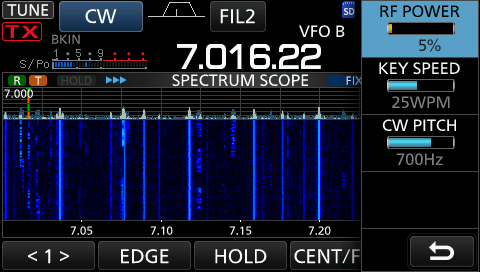
Early morning CW fun on 40m
Update 20/1/2024:
I just got back from the bush after
the SARL QRP contest. To be honest it was a total waste of time! The main
problem was the timing of the contest, from 9:30 local time till 10:30 on 40m
and then from 10:30 till 11:30 on 20m. The problem is 40m closes at around 8am
in the morning and only opens again after 4pm, 20m only opens in the
afternoon.
So whoever decided on using these time slots for a QRP
contest is totally clueless as far as propagation goes!
Anyway, even
though I only made 4 contacts I am happy with my station, everything worked
well and it was easy to setup. The only thing that failed was my portable
station CW paddle, the return spring broke but it had issues before so it is
time to retire it. I really
need a new compact CW paddle! Fortunately the FT-817 supports "microphone
keying", you can use the up and down keys on the microphone to send dots and
dashes, actually works quite well once you get used to it. It does limit my
sending speed to around 22-25wpm but for local contests that is fine, I have
never worked a local station at faster speeds than that anyway.
I did
take a few photos of my portable station as I was planning a small report on
the contest, now I am not so sure it is worth the effort so I might as well
post a few photos here.

Ready for the contest, Yaesu FT-917, ATU-100 tuner
(was not needed but you never know with a new antenna), feeding a EFHW antenna
in an inverted L configuration kept aloft with a Comet 8m portable mast. Power
provided by 2.2Ah 3S LiPo batteries, turned out that 1 was enough despite a
LOT of CQ calling. Battery voltage monitored on a cell level.

Other than the mast everything fits into this small backpack.

Radio showing voltage after lots of calling, I would normally change the
battery when it drops below 11.4V
The next round of this QRP contest is later during the day and in autumn so it
might give better results. I will check propagation during the selected time
slots closer to the contest before making a call if it would be worth the
effort to compete or if it will be a waste of time again like this round.
Update 19/1/2024:
Yesterday late afternoon a nice
cool breeze came up so I decided to put up the EFHW antenna on the Comet mast
in the garden. There is a local QRP contest on Saturday so I decided I might
just enter and running a field or portable station is more fun so I needed to
test the antenna.
It went up easy and a quick scan with the MFJ antenna
analyzer showed that it was still a bit long, as expected but that the SWR on
40, 20 and 15m was fine. On 40m in the CW section it was 1.5:1 so I decided to
try using the antenna for my evening 40m CW QSO. Initially I tested the
antenna with the IC-7300 so that I could use the internal tuner but later I
decided to run the R928+ to simulate the portable station running from the
small 2.2Ah LiPo batteries.
Before it was time for my 40m QSO I managed
to make a few DX contacts on 20m running 5W from the R928+ and the EFHW
sitting under a tree in the garden, fun! Need to do this more often!
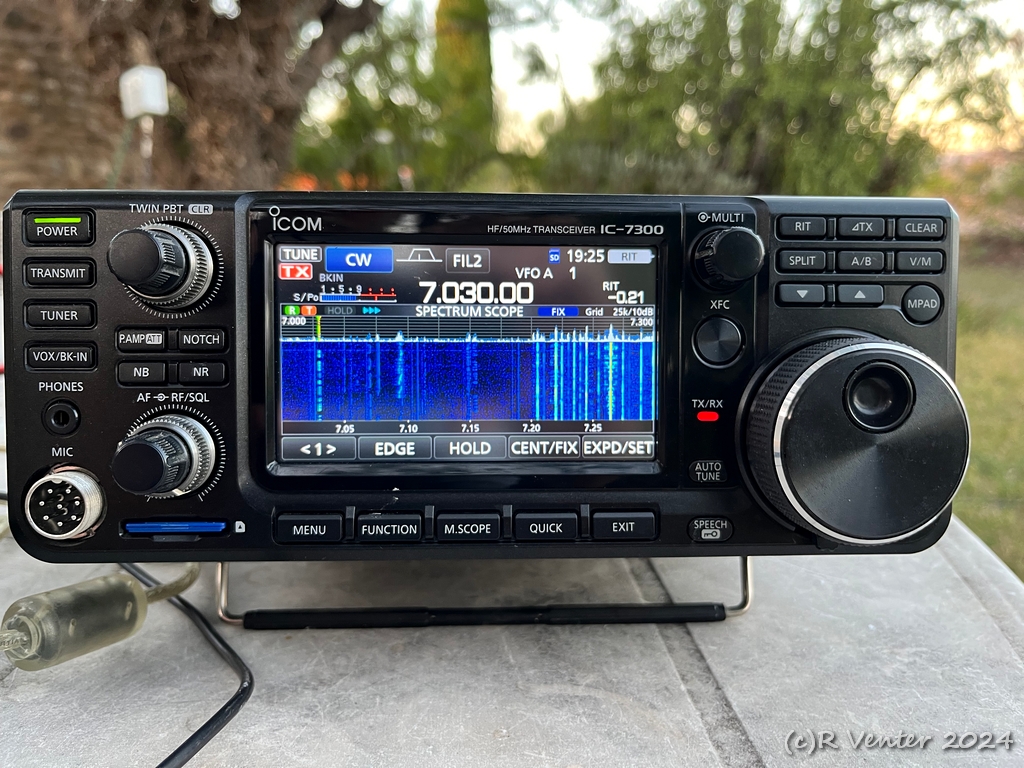
Testing the EFHW in the garden.
My 40m QSO went well (well other than a huge wind storm that came up and
drove me back inside the house after an hour, I had to hold onto the radio to
prevent it from blowing away plus it got really cold!) with signal strengths
very similar to what I normally get on my 40m dipole that is quite a bit
higher, this is great news so the decision was made to go and scout for a nice
spot to put up my portable station for the contest.
I found a nice
spot this morning, it is under a tree on a small hill, it requires a bit of
hiking but not too much. Since I will be traveling light with only a small
backpack and my 8m Comet mast it is not a problem.
The only problem is
the predicted weather for Saturday, with a max temp of at least 41C getting up
in the morning will be fine but by the time I need to go back, around lunch
time, it is going to be VERY hot, will only make the final go/no-go decision
in the morning. Hopefully I will have something interesting to report
tomorrow.
Update 18/1/2024:
I had fun during the CWT session
this morning, the band I chose, 40m, was not quite open when we started but
towards the end of the session signals were stronger. Again it was not that
easy to work stations running 5W but by the end of the session I had 22
contacts in the log.
The FTdx-10 did well and I can see that it would
be a great radio for "casual" contests where you do not need a second
receiver. I am glad I decided to make up a temporary plug that fits the
FTdx-10 for my "ALC power controller", this little device simply feeds a
negative voltage of between 0V and -4V into the ALC port of any radio. Since
the voltage is adjustable this allows you to control the output of the radio.
In the case of the FTdx-10 that has a minimum output of 5W it allows you to
drop the power even lower as I often want to drop the power below 5W to 1W for
QRPp work.
It is amazing what you can work with only 1W and a decent
antenna when the higher bands are open. I really need to get a few 10 pin mini
DIN plugs so that I can run accessories on the FTdx-10, why Yaesu decided to
used this obscure plug only they will know. None of the local electronic
component suppliers list the 10 pin mini DIN plug.
Just after breakfast
I received a message that my package containing the IC-7300 and the AH-4 tuner
had arrived. Once in the shack I checked everything and all was well. The
IC-7300 still has the plastic protection over the face. I switched it on to
check the firmware, it has the latest. The future of this radio has not been
decided, I might keep it or most likely sell it again, I do not really need 2
IC-7300's!

Then there were 2, old and new IC-7300
As I mentioned before the real reason for purchasing the package deal was to get the Icom AH-4 external tuner. I want to use this tuner on the yacht and it could also be used for a mobile installation with a standard 102" whip. I hope to test it soon.
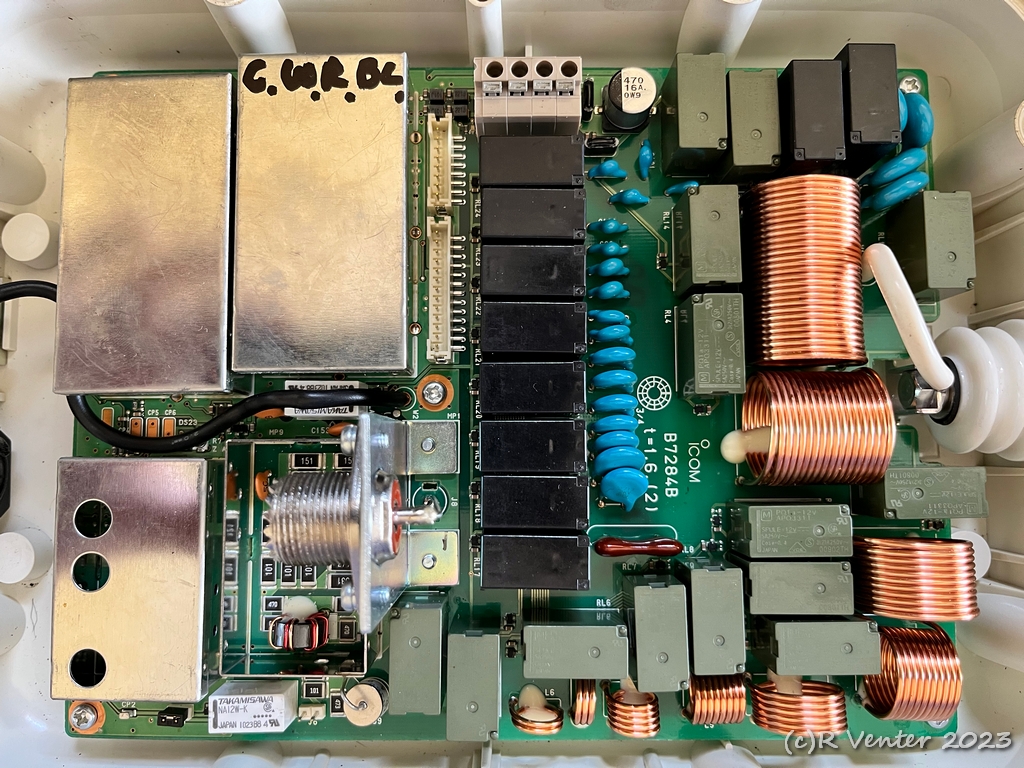
Inside of the Icom AH-4 tuner.
I had planned to do a temporary install of my newly constructed EFLW antenna
today but with the new arrivals in the shack I did not get around to it.
I want to use the antenna for field/portable stations but I first want to test
it, when I get a chance, and it is not too hot like it is at the moment. I
want to throw the antenna over a tree and then setup my portable station
(Yaesu FT-817 or R928+) under the tree and make a few contacts. Might even
have my daily 40m CW chat from under the tree in the garden!
The idea
is to not only test the antenna but also the radio, tuner and power supply.
The power will be provided by LiPo batteries that normally does service in my
RC aircraft. I also want to test the little RF amplifier I assembled, it will
do 55W with 2w of input while running at 11.4V from a 3S LiPo battery. I run
5W 99% of the time but sometimes you might just need a bit more power to chat
comfortably, that is the thought behind using this compact little amplifier.
I am hoping to work some DX later this afternoon or early evening, let's
hope the bands play along!
Update
17/1/2024:
The Yaesu FTdx-10 arrived early
this morning. I wasted no time getting it all connected, CAT for logging via
the USB port and CW paddle as well as CW keying via N1MM+ was setup without
any issues. By the time it was ready the bands were closed but I still managed
to play with it a bit.

FTdx-10 with SP-30 speaker on 40m CW
First impressions were positive. The receiver
sounds really great and the external SP-30 speaker really adds to the sound
quality. The Digital Noise Reduction (DNR) was put to the test immediately as
the 40m band at my QTH can be very noisy during the day. It performed
exceptionally well, so well that I do not see the need for the external QRM
Eliminator like the one I need to use on the IC-7300. This is great news!
Later in the afternoon a made a few SSB contacts and the audio reports
were good, I have not setup the 3 band equalizer yet, maybe I will do it but
for the limited SSB I do it might not be needed.
I used the radio early
evening for some DX'ing and managed to work a few stations including TZ4AM in
Mali on 12m. The signals were very weak but between the bandwidth filters, the
roofing filter and the brilliant Audio Peak Filer (APF) I managed to pull out
signals from the noise that would be difficult on most radios. You can narrow
the band-width right down to 50Hz with amazing results.
Later in the
evening I used the radio for my normal 90 minute CW rag-chew on 40m. It did
really well with the noise reduction shining again on a band full of static. I
also made a point of running high power, 100W to see how hot the radio would
get but even after overs lasting 5 to 6 minutes each I could not detect ANY
increase in temperature! I could also not hear the fan running, this is
amazing! Most other radios would be very hot after a TX session like that!
Well done Yaesu!

Chatting with
ZS3ADY on 40m, lots
of display options! You can see his nice clean signal on the oscilloscope.
After our sked and some tea I moved to 20m to see
if I could hear any stations during the weekly CWT 19:00 session. The last few
weeks I could hear nothing but for a change I could hear a few stations in the
USA and Europe. Signal were weak but running 5W into my hex-beam I managed to
work quite a few, most notable was E77DX in Bosnia - Herzegovina. Again the
great noise reduction and APF helped.
So far I am enjoying the radio, I
will comment on the ergonomics after I have used it for a while.
Update 14/1/2024:
Last night I was listening on 40m
for CW stations, I worked a few local stations but then decided to have a
quick listen on 30m. I was pleasantly surprised to hear lots of DX!
I
had fun working stations from Europe to Antarctica, great to hear so many CW
stations! I really need to make a point of visiting 30m more often.
Worked RI1ANC on 30m CW
RI1ANC at
Vostok station, Antarctica.
RI11ANC
shack, note the 2 x FT-897 radios.
I have mentioned the strange QRM I have been seeing recently, I have seen it on 20m but more often on 40m. I have now identified it as Iranian "Over the Horizon RADAR" but the strange thing is that reports only shows it on the higher bands, not 40m. Maybe it is something else but the modulation looks and sounds exactly the same.
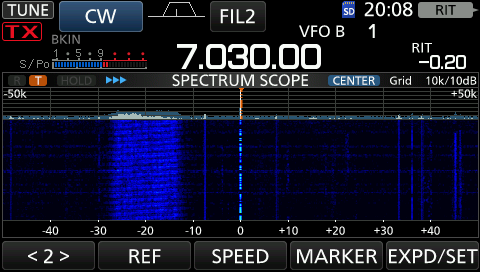
Suspected Over the Horizon RADAR signal to the left
of my CW QSO.
Update 13/1/2024:
The band conditions are still a bit
up and down, often I hear almost nothing and then suddenly I hear strong
signals. I have managed to work a few interesting stations along the way.
I managed to work OY1CT on 17m, I did not think much of it but he came
back to me and said "new band!" so I had a look at my logbook. I see I worked
him for the first time in 2000 and since them I have now worked him on all
bands from 20-10m. I think I now need to work him on 30m and 40m!
QSO's with OY1CT since 2000
As I have posted here before I became a member of the CWOps group in October 2023, I have been enjoying the CWT test sessions and to my surprise I received a certificate for the 15 sessions I did work in 2023, thanks guys!
I have already worked a few sessions in 2024 but I think chances are that it
will slow down a bit in the future, yes, it is great fun to work some really
fantastic CW operators but I seem to work the same 20-30 US stations every
week. That is fine but since my primary interest is DX I think that time, when
the bands are open, could be spent more productively chasing DX. I will see,
maybe as the seasons change and the solar cycle picks up propagation might
change allowing me work CWOps members in other areas of the world. If that
happens I will work more sessions.
My FTdx-10 was shipped this morning,
I have a tracking number so I can keep an eye on it, should be here before
next weekend.
Update 11/1/2024:
Band conditions have been up and
down the last few days, I have worked some DX on 12m as well as quite a few
stations towards my west early morning on 40m.
A notable QSO was LA5ZO,
Geir, on 12m, we had a nice long QSO and exchanged a lot more than just the
usual signal reports. I have to admit that there was a time when I simply
chased DX contacts and worked contests and I was happy with a simple signal
report exchange but these days I am enjoying a bit of a chat as well. It is
interesting to see that quite a few CW stations are more than happy to chat!
On the note of chatting, I am still having a regular sked in the evenings
on 40m with Andy ZS3ADY, a few days ago I also worked Wolter, ZR6HAM, on 40m
before my regular sked, what made this contact interesting was that I found
out that I actually know Wolter from flying. He owned a Streak Shadow aircraft
like I did and I actually test flew it for him years ago after he had some
engine issues. It resulted in one rather rushed landing! We later went off on
a cross country camping flight towards the north of South Africa, great
memories.

Photo of the flying trip with Wolter, in the front
my old Shadow that I sold to a friend, then my Bush Baby I was flying on the
trip and in the background Wolter's Shadow, somewhere in the lowveld.
We also had 2 new guys join us on our 40m rag-chew session last night, really
hoping we will hear them and others again in the future.
I was hoping
to lower my Hex-beam antenna today for maintenance but it is raining lightly
so I think I will postpone till tomorrow. I also want to add a 2m/70cm yagi,
maybe I can make a few SSB/CW contacts on those bands. I am also hoping that I
can get into the coastal repeater network using that antenna, time will tell.
I have had confirmation that due to work commitments from the widow of the
estate I am buying the Yaesu FTdx-10 from, she will only ship the radio this
coming Saturday, that is fine, I can understand why so I am looking forward to
receiving it sometime next week.
Update 6/1/2024:
After a few weeks of relatively bad
propagation things are slowly getting better. Last night I managed to work a
few stations on 15 and 20m. this morning I heard stations from areas in the
world on 40m that I have not heard for a while. This includes the Caribbean,
central and South America as well as a few stations from the Pacific. I also
heard and worked a station from Rodriquez Isle on 20m, it was the only station
I could hear but he was S9_30db!
Another nice surprise this morning
was V31XX, Belize on 40m, not a new one but great fun to
break the pile-up with 5W!
V31XX, Belize on 40m, nice antenna
stack!
This afternoon there was quite a bit of activity on 12m and I had fun
working stations from Europe. 10m was quiet, I think the MUF did not rise
quite that high.
I received a QSL via LoTW for a QSO I had with a
station in Eastern Malaysia on 17m in October last year, it is a new one on
17m so that is great.
A few days ago I reported a QSO with Doug,
KR2Q on 30m that I enjoyed, I was pleasantly surprised to
receive an email from him telling me it was his first confirmed 30m QSO with
South Africa, love it!
I am also happy to report that there has been
progress on the purchase of the new, still in the box, FTdx-10 from the estate
of a friend. Hopefully it can now be shipped in the next few days so that I
can be at home to receive it before my planned trip to Durban. I am really
missing my yacht, can't wait to spend time on it again!
Update 3/1/2024:
While testing the Flex 5000A
yesterday I worked a few DX stations on various bands. This morning while
looking at my latest QSO confirmations on LoTW I noticed that one of the
stations I worked was 5H6PJ, Tanzania, turns out that he was
a new band-spot for me on 15m! So 2024 has indeed started well, an all time
new one on the first day and a new band-slot on the second day!
Unfortunately band conditions seem to be rather poor today, maybe late
afternoon or early evening will produce better results.
I have now used
the Flex 5000A for a few days and I am quite happy with the improvement the
new Firewire interface card has brought. I have had no further latency issues.
Yesterday I had, over a few hours of operation, 3 occasions where the DSP, and
thus the received audio, crashed/froze for about a second, every time it did
recover by itself. I have also had 2 occasions where the computer crashed
completely forcing a hard reset while using the SDR software. On both
occasions it happened just after booting the system and then opening the
software, the moment you then try to change frequency or band the computer
would crash. I did a few tests and if you wait for about 30 seconds after
starting the computer before you run the software it does not happen.
I
think it is most likely caused by the computer still being busy from the boot
and then the SDR software running at "High priority" causes MS windows to
crash. I am sure a faster computer will also prevent this.
On the
subject of a faster computer, I have been doing some online research to see
what is available and I have found a few options. I want to order but might
wait till next week as many businesses are still closed and from experience I
know that I have often had problems with orders place while companies are
still closed for holidays. The orders are often missed/forgotten or they get
them wrong.
Unfortunately there has also been no progress with the
shipping of my Yaesu FTdx-10, I was hoping it would be possible to ship it no
later than today but I am still waiting for information to finalize the deal
and book the courier to pick up the radio. I think I will give it till the end
of the week but if it does not happen I will simply cancel the deal and order
directly from the USA, there would not be much of a price difference anyway.
If I did that in the first place I would have had the radio already.
I
was sitting in the shack yesterday afternoon sorting out some cables, while
doing that I was listening on 40m to a few guys calling and chatting on CW.
One thing that stood out was that there are a few great CW operators in South
Africa, unfortunately it was also quite clear that quite a few guys, mostly
newer operators, do not understand some of the operating practices. Sadly this
includes at least one self proclaimed "expert".
Here are a few things
that I noticed:
1) When calling CQ you should call like this "CQ
de ZSxxx ZSxxx pse k" and not "CQ ZSxxx BK" or just "ZSxxx BK", BK is used to
interrupt a QSO for a quick questions and has no place when calling CQ!
2)
In general there seems to be a lack of understanding of how and when to use
prosigns.
3) When you have replied to a CQ and you have worked the station
you then move away from the frequency! You do NOT then start calling CQ on the
frequency where the other guy called CQ, this is simply bad manners!
4) Do
not try to send stylish/swanky CW by stretching some elements, often the last
element of a character, this will simply get you classified as having a "bad
fist" and being a LID.
5) When you reply to a CQ please try to at least get
a reasonable "zero beat" with his signal, I often hear guys replying to a call
but they are so far away from the frequency that they often fall outside the
caller's narrow CW filter or they are so far way the caller thinks they are
replying to someone else. It is simply bad operating practice to do that. Read
up and understand how to "zero beat" a CW station before replying.
6)
Do not try to send CW faster than the speed you can actually send accurately
at, you often end up sending CW that is not accurate. There is a local station
that often ends up sending his call as ZS67xx or even Z67xxx, maybe record
yourself and listen to your own CW.
I have enjoyed using the Flex 5000A
the last few days but I have realized that it will never be a great contest
radio, and this goes for all "full SDR, computer controlled radios". The
problem is that when you are running in "search and pounce" mode, moving up
and down the band it is rather slow to get to the calling stations frequency
quickly to "zero beat" him. This is because you can see his signal on the
waterfall and click on it, great, but that will seldom if ever get you on
exactly the right frequency. Now you need to "fine tune" your frequency before
you can reply.
With a conventional radio you simply use the VFO dial
to do that, takes less than a second, on the computer controlled SDR you need
to click on the displayed frequency, the correct digit, to set the level of
fine tuning you need and the using the mouse wheel you can move up and down.
You then often have to click on a lower value digit for the final fine tuning.
This takes FAR too long!
I suppose it will be less of a problem when
working with wide SSB signals but for CW and RTTY this is really not great!
This way of operating is fine for rag-chewing or even DX'ing where you are not
changing frequency all the time but for contesting it will be VERY
frustrating!
Update 2/1/2024:
Some good news It seems like the
Flex 5000A is behaving itself far better. I managed around 5 hours of
operating with it yesterday and it worked well. I worked some DX on a few
bands and I also used it for my evening CW torture test QSO. During that time
the waterfall did twice briefly freeze for a second or so but it did recover
by itself. I had no total software crashes and most importantly the latency is
now low enough that it is no longer a problem on CW.
I am pretty sure
the brief freezes were caused by an overloaded CPU on the laptop I am using as
both times it happened while I was doing something else on the computer that
pushed the CPU load up. It is an i7 dual core, 4 thread CPU so not fast
compared to modern computers. I have decided to acquire a decent desktop
computer with at least 4 or more cores, then I can also used the faster PCIE
Firewire card. The computer will then become my dedicated amateur radio
computer.
I would like to find something compact and most likely a
"brand name" computer as I want something reliable that I do not have to
"fiddle" with all the time. I have also found that certified (FCC and CE)
brand name computers also cause a lot less interference that some of the
no-name brands,
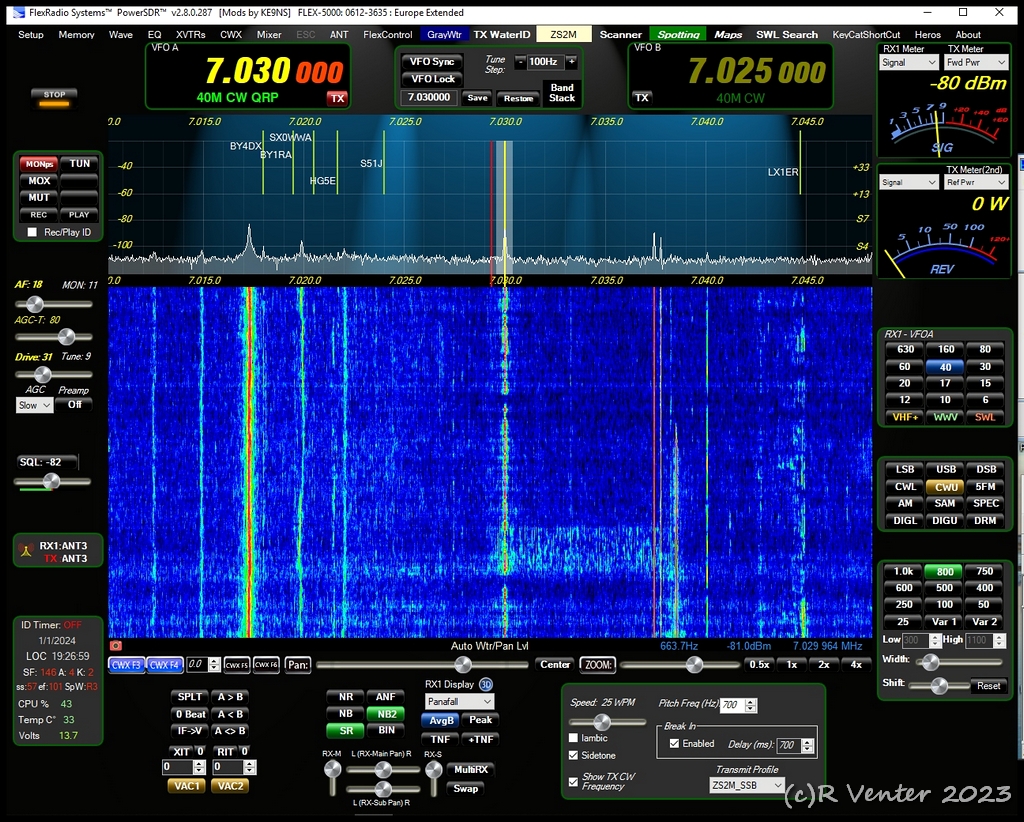
Flex 5000A in action, lots of noise on the band but
the super filters cope with that easily.
I am really glad that I have managed to get acceptable results from the Flex,
I must admit I was rather disappointed with it for a while and I almost sold
it. With a bit of luck a decent computer will make it even better!
I
think I will use the Flex for this week's CWT sessions, if it can handle that
it might just convince me to consider a Flex 6700 in the future!
Another very pleasant surprise was the QSL that I received from V85A, Brunei,
for a 40m contact we had recently. This is not only a new one on 40m it is
also an all-time new one! Last time I had an all-time new one was beginning of
last year when I worked Bouvet.
Nice QSL card from V85A in Brunei
Update 1/1/2024:
So here we are in 2024 already! Happy
New Year Everyone!
Let's
hope this will be a "radio active" year with lots of fun on the air!
This year started of well, early this morning I was in the shack and
decided to see if there was any life on the bands, I could not hear much but
decided to call CQ on 30m, I very seldom listen on 30m so I mainly wanted to
check my antenna and also wanted to see if my signal was picked up anywhere in
the world on the reverse beacon network.
I sent a CQ and immediately I
could see that I was being heard in the USA, to my surprise I also received a
reply to my CQ from a station in the USA (WB3CQM),
after having a nice chat to him, signals were 599 both ways I worked a few
more stations before being called by my friend and fellow CWOps member Dough
KR2Q, was a nice surprise to
hear him on 30m. We ended up having a 2 way QRP contact when we both dropped
to 5W. We had a nice long QSO great fun! Let's hope this is a sign of good
things to come in 2024.
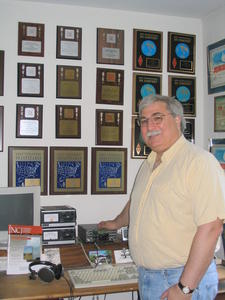
Doug, KR2Q, great CW operator and contester!
I recently acquired a new PCIE Firewire card
for my laptop, actually I received it quite a while ago but since I was rather
upset with my Flex 5000A and Flex Radio in general I did not feel like testing
it and I was close to selling the Flex 5000A, it is a great radio and for a
SSB only operator it will be fine but for CW it has been nothing but a
frustration so far. Well this morning I decided to give it a quick test and so
far so good. The latency seems to be a lot better, only problem is I have not
used the laptop for quite a while so now Micro$oft wants to do a major update
and that slows a computer down badly, not something you want to happen while
you are running time critical software.
So after a few tests I decided
I will leave the laptop to do it's update, once it is done I will disable all
updates and then try to use the radio. If it works well I will try to use it
for my evening CW QSO with Andy,
ZS3ADY, if it can survive that long QSO
without crashing or developing lots of latency like it did in the past I will
try the radio for a while as my general DX and QSO radio. Let's hope for the
best!
I
am hoping I can do a bit of semi local traveling this year that will also
include a few amateur field stations and maybe even some mobile operation.
First opportunity will be my planned trip to Durban towards the end of the
month to get some work done on my yacht.
I am hoping that my new Yaesu
FTdx-10 will be shipped in the next 2 days, can't wait to get it on the air to
see why everyone is so impressed with the new technology that Yaesu has
incorporated in the FTdx-101 and the FTdx-10. I am hoping that it will replace
the IC-7300 as my "low power consumption" compact radio in the shack and for
field station use. I can then move the IC-7300 to the yacht permanently.
I do not really have major plans for other new radios this year. If the
FTdx-10 really impresses me I might just add a FTdx-101MP to the shack as the
new "main DX and contest" radio. I am also still looking for an IC-7800/7851
in a good condition and a great price. I have been offered a few 7800's but
the prices were crazy, especially on the IC-7800 that is now an old radio with
a less than spectacular receiver.
Home
(c)R Venter 2024